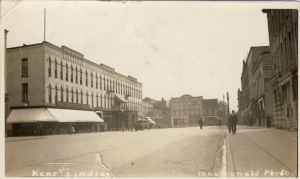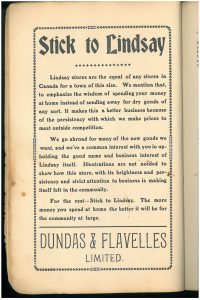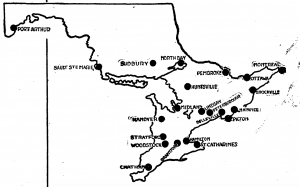Adjusting to Modernization
Incidental to the growth of the business, the threat posed by larger department stores loomed over William Flavelle. The business he built for over three decades was at risk of becoming redundant and irrelevant.

Kent Street in Lindsay with Dundas & Flavelles Ltd in the foreground with its awning open. ca. 1920s.
The techniques employed by The T. Eaton Company and others were out of reach for Dundas & Flavelles. Reaching a customer base outside of the local area became increasingly difficult. Toronto businesses were more numerous and had far more money to spend on marketing their goods. To counter the growing Toronto market and increasing mail-orders from Victoria County, William sought to create a “shop local” campaign in order to highlight the benefits of keeping money in Lindsay. His appeal was compelling to the area residents, who continued to purchase from Dundas & Flavelles for decades.
Still, outside competition was not something that William could ignore. Shoppers who took the train to Toronto came back to describe an experience that had not yet reached Victoria County. Prompted by this feedback, William instituted new policies that allowed for convenient shopping. Mechanisms were implemented to allow customers to grab and go without the need for a clerk. Clerks slowed convenience and customer satisfaction was a top priority. William continued to expand the business finding new ways to make the customer experience enjoyable. If customers traveled by train in 1914, their newly bought parcels could be shipped to the station for pickup before boarding.
The expansion climaxed in 1925 with the addition of the Lindsay Beauty Parlour located on the second floor. Like many businesses during this period of modernization, acquisitions were frequent. Dundas & Flavelles Limited was not immune to this process.and was sold to The Canadian Department Stores in late 1925. It was one of 13 stores to merge into what would become the largest chain department store system in Canada at the time, though the Dundas and Flavelle name remained above the doors for two more years as a transitional marketing tactic.



